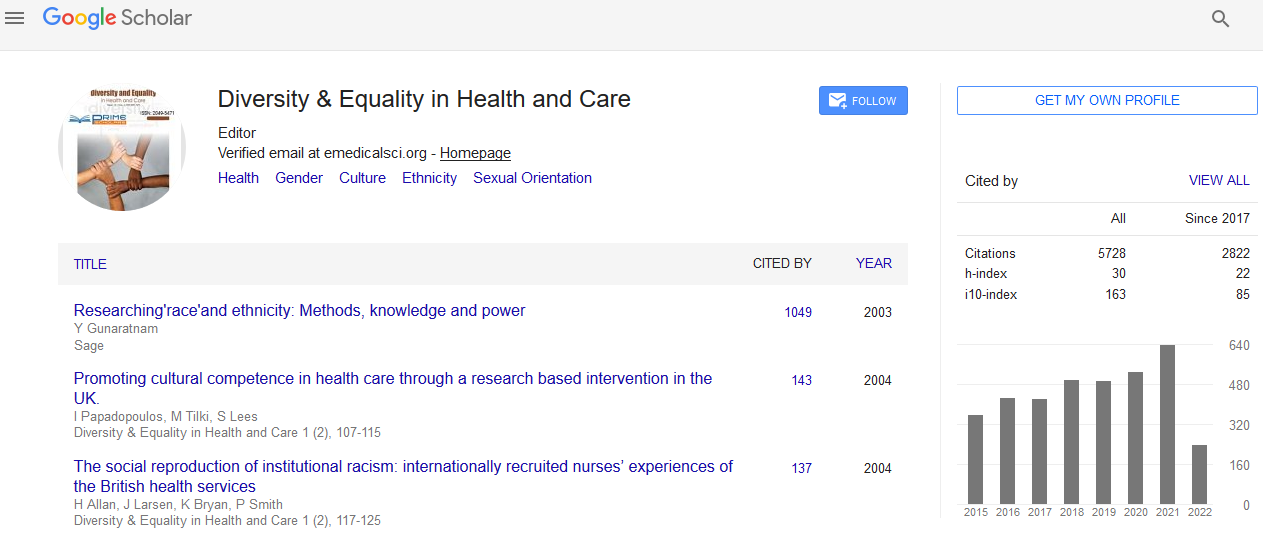Short Communication - (2024) Volume 21, Issue 6
Understanding Health Disparities: A Critical Barrier to Equitable Healthcare
Aoi Yamada*
Department of Sciences, Kyoto University, Japan
*Correspondence:
Aoi Yamada,
Department of Sciences, Kyoto University,
Japan,
Email:
Received: 02-Dec-2024, Manuscript No. IPDEHC-25-22094;
Editor assigned: 04-Dec-2024, Pre QC No. IPDEHC-25-22094 (PQ);
Reviewed: 18-Dec-2024, QC No. IPDEHC-25-22094;
Revised: 23-Dec-2024, Manuscript No. IPDEHC-25-22094 (R);
Published:
30-Dec-2024, DOI: 10.35248/2049-5471-21.6.51
Introduction
Health disparities refer to the unequal access to healthcare services and differences in health outcomes among different
populations. These disparities often arise due to a combination
of socioeconomic, environmental, and cultural factors that
impact an individual’s ability to achieve optimal health. In many societies, certain groups, including racial and ethnic minorities, low-income communities, rural populations, and people with
disabilities, face significant health inequities. Addressing health disparities is essential not only for improving individual health
outcomes but also for fostering a more just and equitable healthcare system. Health disparities stem from a complex
interplay of factors. One of the most significant contributors
is socioeconomic status (SES). People from lower-income backgrounds often experience poor living conditions, limited
access to quality education, and reduced access to healthcare services. These factors contribute to higher rates of chronic diseases, mental health issues, and shorter life expectancies.
Description
For instance, individuals in low-income neighbourhoods may live in areas with limited access to healthy food (food deserts), inadequate housing, or poor environmental conditions, all of which exacerbate health issues. Another critical factor
is racial and ethnic disparities. Studies have shown that
people of colour, particularly Black, Latino, and Indigenous populations, experience higher rates of chronic diseases such as hypertension, diabetes, and cardiovascular disease
compared to their white counterparts. These health disparities are often rooted in both historical and systemic racism that manifests in various ways, including limited access to care, unequal treatment by healthcare providers, and implicit
biases in medical practice. Additionally, social determinants
of health such as education, income, and employment-tend
to disproportionately affect these communities. Geographical
location also plays a pivotal role in health disparities. Rural populations face unique challenges, including limited
healthcare infrastructure, fewer healthcare professionals,
and increased travel distances to access care. These barriers result in delayed diagnoses, inadequate preventive care, and
poor management of chronic conditions. Conversely, urban centres may offer advanced medical technologies, but they
can also struggle with overcrowded facilities, environmental pollution, and a higher burden of infectious diseases. The
impact of health disparities goes beyond individual suffering-it has broad societal consequences. Disparities contribute to the
inefficiency and unsustainability of healthcare systems. People in underserved communities often seek care at later stages of illness, leading to higher medical costs due to emergency room visits and hospitalizations. Furthermore, a lack of timely access to healthcare perpetuates cycles of poverty and exacerbates health outcomes for future generations [1-4].
Conclusion
Health disparities also contribute to lower productivity and
economic instability. Poor health among disadvantaged
populations leads to absenteeism from work, disability, and
a diminished quality of life. This, in turn, affects the economy by increasing healthcare costs and reducing the labour force. Addressing health disparities can not only improve quality of life for individuals but also provide economic benefits at the
community and national levels. Health disparities represent a major challenge to achieving health equity globally. Addressing
these disparities requires a concerted effort from policymakers, healthcare providers, and communities alike. By working together to address the root causes of health disparities, we
can build a more inclusive healthcare system and improve the
health and well-being of underserved populations. As we move
forward, ensuring equal access to healthcare and addressing the social determinants of health should remain central goals in the pursuit of a healthier, more equitable world.
Acknowledgement
None.
Conflict Of Interest
The author’s declared that they have no conflict of interest.
References
- Tandon R, Gaebel W, Barch DM, Bustillo J, Gur RE, et al. (2013) Definition and description of schizophrenia in the DSM-5. Schizophr Res 150(1):3-10.
[Crossref] [Google Scholar] [PubMed]
- Tandon R (2013) Schizophrenia and other psychotic disorders in DSM-5. Clin Schizophr Relat Psychoses 7(1):16-9.
[Crossref] [Google Scholar] [PubMed]
- Morera-Fumero AL, Abreu-Gonzalez P (2013) Role of melatonin in schizophrenia. Int J Mol Sci 14(5):9037-50.
[Crossref] [Google Scholar] [PubMed]
- Monteleone P, Natale M, Rocca AL, Maj M (1997) Decreased nocturnal secretion of melatonin in drug-free schizophrenics: No change after subchronic treatment with antipsychotics. Neuropsychobiology 36(4):159-63.
[Crossref] [Google Scholar] [PubMed]
Citation: Yamada A (2024) Understanding Health Disparities: A Critical Barrier to Equitable Healthcare. Divers Equal Health Care. 21:51.
Copyright: © 2024 Yamada A. This is an open-access article distributed under the terms of the Creative Commons Attribution License, which permits unrestricted use, distribution, and reproduction in any medium, provided the original author and source are credited.

